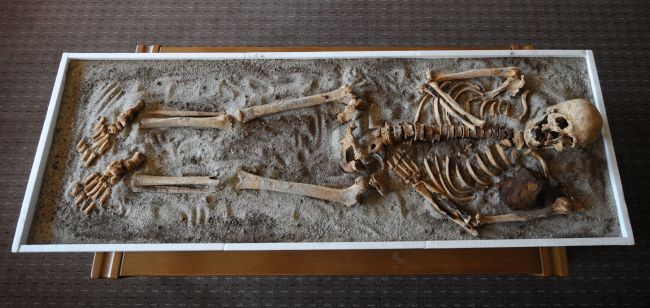
The ancient skeleton of a man, pinned down in his grave in order not to turn into a vampire, was put on show in Bulgaria last week, where vampire tales and rites still keep their bite even nowadays.
The 700-year-old skeleton -- unearthed in the necropolis of a church in the Black Sea town of Sozopol earlier in June -- was stabbed in the chest with an iron rod and had his teeth pulled before being put to rest.
Anti-vampirism rituals were behind the find, archaeologists said, making this potential vampire and another one found at his side an instant media hit.
"These were most probably intellectuals who outgrew the moral ideas of their 14th century (...) They were feared and buried outside town walls," their discoverer, archaeologist Dimitar Nedev, told AFP.
The national history museum in Sofia displayed one of the skeletons this week as "a strange proof of the beliefs and superstitions of our ancestors,"
its chief Bozhidar Dimitrov said in a statement.
"A museum employee kept making the sign of the cross while washing the bones," he said, noting that vampire fears were still alive.
Not only fears but also anti-vampirism funeral rites are still strong in Bulgaria even today, ethnologist Rachko Popov confirmed.
The researcher -- known among his university colleagues as "the vampirologist" -- described the vampire in the Bulgarian folklore tradition as a villain or somebody very old, who usually fed on domestic animals' blood but could also attack humans.
People also imagined vampires as very ugly and asymmetrical -- hunchbacked, lame or one-eyed, Popov added.
Vampires were believed to fear water, and entire villages in the southeastern Strandzha mountain zone were known to have moved town to the opposite banks of rivers in order to escape, he said.
Signs of various practices to prevent the dead from rising again as vampires have been discovered at different archaeological sites across Bulgaria over the years. (AFP)
<관련 한글 기사>
'불가리아산 흡혈귀’ 구경 한번 하시려우?
두개골과 팔다리에 못이 박힌 유골, 가슴에 쇠 막대가 박힌 시신 등 과거의 '반(反)흡혈귀 의식'을 보여주는 유골 전시가 17일(현지시간) 불가리아 소피아국립역사박물관에서 열려 화제다.
전시품 중 이달 초 흑해 연안 소조폴에 있는 교회의 공동묘지에서 발굴된 유골은 가슴에는 쇠막대가 박혀 있고 치아가 모조리 뽑혀 있다.
또 불가리아 벨리코투르노보주(州)에서 발견된 유골은 쇠로 된 수갑에 묶여 땅에 고정돼있었으며 무덤가에는 타다 남은 불씨의 흔적이 남아있기도 했다.
소피아국립역사박물관의 보이다르 디미트로프 관장은 이 유골들을 "우리 조상들 이 갖고 있던 이상한 믿음과 미신의 증거"라고 묘사했다.
그러나 일부 시민들은 지금도 죽은 자가 흡혈귀로 변하지 않도록 반흡혈귀 의식을 시행하는 등 불가리아에서 흡혈귀에 대한 믿음은 여전히 '현재 진행형'이다.
노보셀로 북서부에 거주하는 시민 자라 디미트로바는 "4년 전 남편이 죽은 후, 내 여동생이 그의 영혼이 흡혈귀로 부활하지 않도록 무덤가를 막대로 찌르고 성가를 부르는 등 그의 무덤에서 반흡혈귀 의식을 거행했다"고 밝혔다.
또 소피아에서 통역사로 일하고 있는 발리아 이바노바는 "숙모가 죽은 남편이 흡혈귀가 되지 않도록 다리를 구두끈으로 묶어 관에 눕혔다"고 회상하기도 했다.
한편 일부 관계자들은 최근의 '흡혈귀' 발견이 다가오는 휴가철을 맞아 불가리아의 관광 산업에 활기를 불어넣어 줄 것이라며 환영의 목소리를 내고 있다.
흑해 인근 휴양지의 식당과 술집에서는 이미 '흡혈귀 스테이크', '흡혈귀 칵 일' 등 흡혈귀 관련 메뉴가 출시돼 관광객들의 발길을 끌고 있다.
또 소조폴은 발칸반도에서 가장 유명한 흡혈귀 '드라큘라 백작'의 출생지인 루마니아의 시기쇼아라와 자매결연을 하고 관련 관광산업에 박차를 가할 예정이다.






![[KH Explains] How should Korea adjust its trade defenses against Chinese EVs?](http://res.heraldm.com/phpwas/restmb_idxmake.php?idx=644&simg=/content/image/2024/04/15/20240415050562_0.jpg&u=20240415144419)











![[Today’s K-pop] Stray Kids to return soon: report](http://res.heraldm.com/phpwas/restmb_idxmake.php?idx=642&simg=/content/image/2024/04/16/20240416050713_0.jpg&u=)